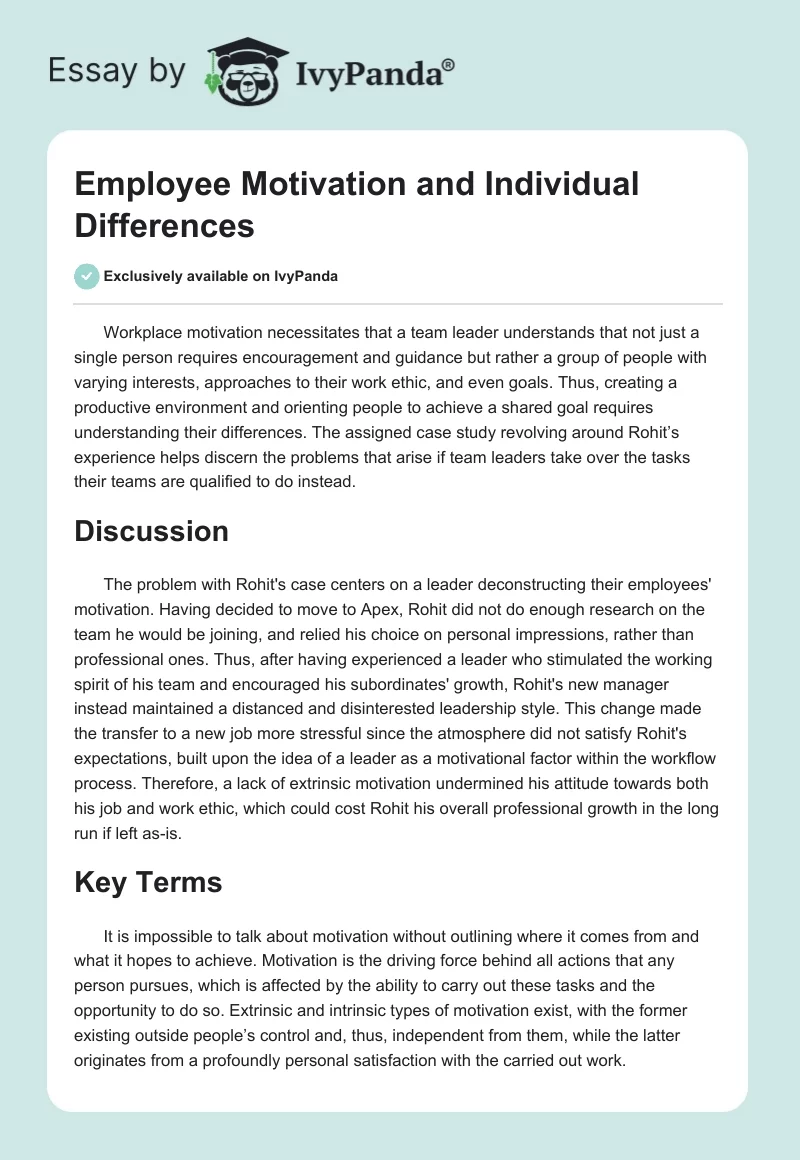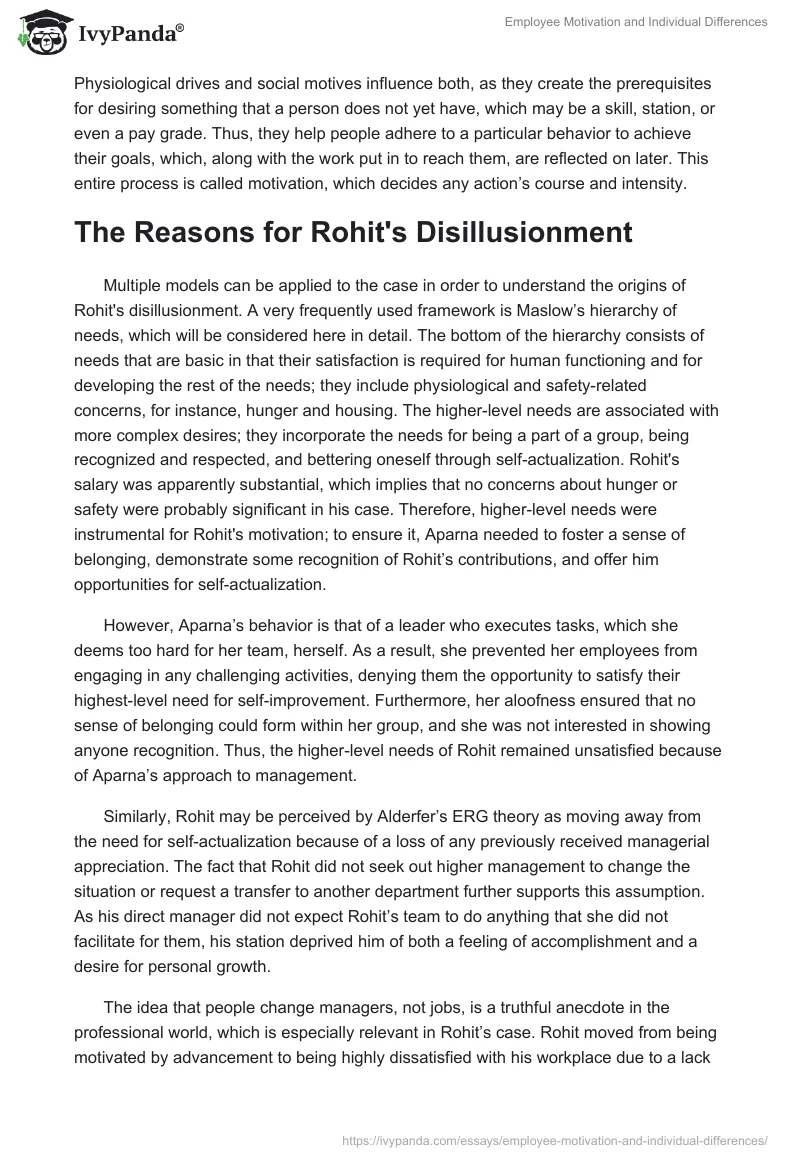Workplace motivation necessitates that a team leader understands that not just a single person requires encouragement and guidance but rather a group of people with varying interests, approaches to their work ethic, and even goals. Thus, creating a productive environment and orienting people to achieve a shared goal requires understanding their differences. The assigned case study revolving around Rohit’s experience helps discern the problems that arise if team leaders take over the tasks their teams are qualified to do instead.
Discussion
The problem with Rohit’s case centers on a leader deconstructing their employees’ motivation. Having decided to move to Apex, Rohit did not do enough research on the team he would be joining, and relied his choice on personal impressions, rather than professional ones. Thus, after having experienced a leader who stimulated the working spirit of his team and encouraged his subordinates’ growth, Rohit’s new manager instead maintained a distanced and disinterested leadership style. This change made the transfer to a new job more stressful since the atmosphere did not satisfy Rohit’s expectations, built upon the idea of a leader as a motivational factor within the workflow process. Therefore, a lack of extrinsic motivation undermined his attitude towards both his job and work ethic, which could cost Rohit his overall professional growth in the long run if left as-is.
Key Terms
It is impossible to talk about motivation without outlining where it comes from and what it hopes to achieve. Motivation is the driving force behind all actions that any person pursues, which is affected by the ability to carry out these tasks and the opportunity to do so. Extrinsic and intrinsic types of motivation exist, with the former existing outside people’s control and, thus, independent from them, while the latter originates from a profoundly personal satisfaction with the carried out work. Physiological drives and social motives influence both, as they create the prerequisites for desiring something that a person does not yet have, which may be a skill, station, or even a pay grade. Thus, they help people adhere to a particular behavior to achieve their goals, which, along with the work put in to reach them, are reflected on later. This entire process is called motivation, which decides any action’s course and intensity.
The Reasons for Rohit’s Disillusionment
Multiple models can be applied to the case in order to understand the origins of Rohit’s disillusionment. A very frequently used framework is Maslow’s hierarchy of needs, which will be considered here in detail. The bottom of the hierarchy consists of needs that are basic in that their satisfaction is required for human functioning and for developing the rest of the needs; they include physiological and safety-related concerns, for instance, hunger and housing. The higher-level needs are associated with more complex desires; they incorporate the needs for being a part of a group, being recognized and respected, and bettering oneself through self-actualization. Rohit’s salary was apparently substantial, which implies that no concerns about hunger or safety were probably significant in his case. Therefore, higher-level needs were instrumental for Rohit’s motivation; to ensure it, Aparna needed to foster a sense of belonging, demonstrate some recognition of Rohit’s contributions, and offer him opportunities for self-actualization.
However, Aparna’s behavior is that of a leader who executes tasks, which she deems too hard for her team, herself. As a result, she prevented her employees from engaging in any challenging activities, denying them the opportunity to satisfy their highest-level need for self-improvement. Furthermore, her aloofness ensured that no sense of belonging could form within her group, and she was not interested in showing anyone recognition. Thus, the higher-level needs of Rohit remained unsatisfied because of Aparna’s approach to management.
Similarly, Rohit may be perceived by Alderfer’s ERG theory as moving away from the need for self-actualization because of a loss of any previously received managerial appreciation. The fact that Rohit did not seek out higher management to change the situation or request a transfer to another department further supports this assumption. As his direct manager did not expect Rohit’s team to do anything that she did not facilitate for them, his station deprived him of both a feeling of accomplishment and a desire for personal growth.
The idea that people change managers, not jobs, is a truthful anecdote in the professional world, which is especially relevant in Rohit’s case. Rohit moved from being motivated by advancement to being highly dissatisfied with his workplace due to a lack of hygiene factors, such as Aparna’s supervision and interpersonal team relationships, as per Herzberg’s two-factor theory. Additionally, it is possible to identify both Rohit and his supervisor using McClelland’s Achievement Motivation Theory, as they fall respectively into the achievement-dominant and power-dominant category. Therefore, since his work became a simple matter of following orders, with no faith placed on the team to find solutions for themselves, Rohit lost first his extrinsic and then intrinsic motivation.
Rohit’s Actions to Resolve His Situation
Since Rohit is unable to control Aparna’s actions, it may be necessary to seek out higher-standing managers within the company and search for an opening in another department or even look for a new job. As a power-dominant manager, Aparna may be open to neither constructive criticism nor requests to vest more power in her team. Rohit’s best interests lie in satisfying his need for being recognized as the professional he is, demonstrated by his standing and growth in Zen, and retaining the desire for working hard and with stellar results. Switching departments, jobs, or managers is essential before he completely loses the drive to be a better professional. Thus, communication with someone sympathetic to his cause may be Rohit’s best plan, especially as he may bring to light with an intercompany executive the possibility of bettering of the productivity of Aparna’s team.
Assuming that Aparna wants to make changes to her leadership style, for example, to achieve higher productivity or to satisfy an order, she may try to create better lines of communication with her team while paying attention to needs and motivations as defined by Maslow’s and other models. Allowing her employees to participate in the decision-making process is an evident change that demonstrates attention to recognition and self-actualization needs, but if Aparna continues to act dismissive of others’ ideas, it may not be enough. Furthermore, acknowledging the variety of the intra-team drives and motives is essential to creating a better working environment, which the possibility of attaining the goals set by all team members for themselves inspires. This course of action may allow not only heightening productivity and workplace satisfaction but also nurturing a corporate spirit, which is indispensable in a substantially large company like Apex. Thus, any leader must be accessible to their subordinates, understand their employees’ professional interests, motivation, and needs, and have enough of their employees’ support to achieve a high level of motivation within their teams.


